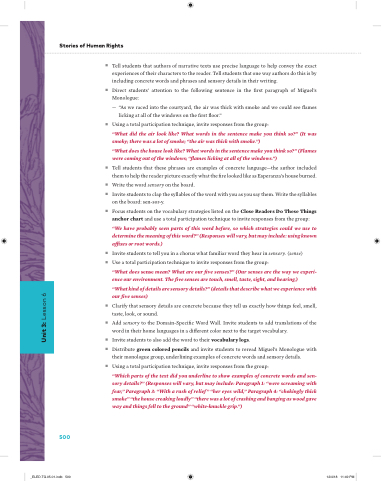Page 524 - EL Grade 5 Teacher Guide
P. 524
Stories of Human Rights
■
■
■
■
■ ■
■
■ ■
■
■
■ ■
■
Tell students that authors of narrative texts use precise language to help convey the exact experiences of their characters to the reader. Tell students that one way authors do this is by including concrete words and phrases and sensory details in their writing.
Direct students’ attention to the following sentence in the rst paragraph of Miguel’s Monologue:
— “As we raced into the courtyard, the air was thick with smoke and we could see ames licking at all of the windows on the rst oor.”
Using a total participation technique, invite responses from the group:
“What did the air look like? What words in the sentence make you think so?” (It was smoky; there was a lot of smoke; “the air was thick with smoke.”)
“What does the house look like? What words in the sentence make you think so?” (Flames were coming out of the windows; “ ames licking at all of the windows.”)
Tell students that these phrases are examples of concrete language—the author included them to help the reader picture exactly what the re looked like as Esperanza’s house burned.
Write the word sensory on the board.
Invite students to clap the syllables of the word with you as you say them. Write the syllables
on the board: sen-sor-y.
Focus students on the vocabulary strategies listed on the Close Readers Do These Things
anchor chart and use a total participation technique to invite responses from the group:
“We have probably seen parts of this word before, so which strategies could we use to determine the meaning of this word?” (Responses will vary, but may include: using known a xes or root words.)
Invite students to tell you in a chorus what familiar word they hear in sensory. (sense) Use a total participation technique to invite responses from the group:
“What does sense mean? What are our ve senses?” (Our senses are the way we experi- ence our environment. The ve senses are touch, smell, taste, sight, and hearing.)
“What kind of details are sensory details?” (details that describe what we experience with our ve senses)
Clarify that sensory details are concrete because they tell us exactly how things feel, smell, taste, look, or sound.
Add sensory to the Domain-Speci c Word Wall. Invite students to add translations of the word in their home languages in a di erent color next to the target vocabulary.
Invite students to also add the word to their vocabulary logs.
Distribute green colored pencils and invite students to reread Miguel’s Monologue with
their monologue group, underlining examples of concrete words and sensory details.
Using a total participation technique, invite responses from the group:
“Which parts of the text did you underline to show examples of concrete words and sen- sory details?” (Responses will vary, but may include: Paragraph 1: “were screaming with fear,” Paragraph 3: “With a rush of relief ” “her eyes wild,” Paragraph 4: “chokingly thick smoke” “the house creaking loudly” “there was a lot of crashing and banging as wood gave way and things fell to the ground” “white-knuckle grip.”)
500
_ELED.TG.05.01.indb 500
12/4/18 11:49 PM
Unit 3: Lesson 6


